
|
|

|
Hokusai - Ehon Sumida Gawa - Prints 3-2 and 3-3

|
|

|
At this point, summer shifts into autumn ...
In the foreground we have a view of the quarter of Hanakawadochō (花川戸町) with its numerous restaurants and the residence of the hero of the popular kabuki play “Sukeroku” (助六). The full name of this fictional kabuki character is in fact Hanakawado Sukeroku. For more information concerning this popular kabuki character, please have a look at Serge Astières’s Shin-hanga website here.
In the mid-distance Mukōjima (向島, which literally translates into “opposite side island”), the district on the east bank, contained some sixteen villages as well as several shrines. On the right in print 3-2 we see the Mimeguri shrine (三圍神社, which translates into “three circles shrine”), its torii gate partly hidden by the embankment. The Mimeguri shrine is home to Daikokuten, the god of wealth or of the household, particularly the kitchen, and to Ebisu, the god of fishermen, luck, and workingmen, as well as the guardian of the health of small children. In the left of print 3-3, we see the shrine of Ushinogozen (牛の御前, which translates into “before the cow”) located in the village of Susaki (須崎村).
Daikokuten and Ebisu are two of the seven gods of good fortune in Japanese mythology and folklore (the other five being Hotei, Jurōjin, Fukurokuju, Bishamonten, and Benzaiten). This is a print depicting these two lucky gods designed by Toyota Hokkei and reproduced by David Bull in 2002 (click to enlarge):

|
Ebisu (on the right) and Daikokuten (on the left) by Toyota Hokkei |
Mimeguri shrine has been depicted in Japanese prints many times. Here is one by Hiroshige that nicely complements Hokusai’s prints 3-4 and 3-5. It is a view from the east bank of the river showing the torii gate of Mimeguri shrine in the foreground and Matsuchiyama hill, Shōden shrine, and Imado bridge on the west bank of the river (click to enlarge):
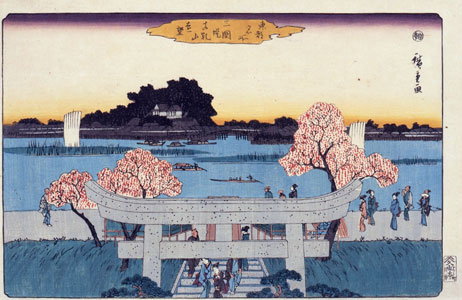
|
Distant View of Mimeguri Embankment and Matsuchiyama by Utagawa Hiroshige (ca. 1843-1847). |
These are three pictures I took of Mimeguri shrine in April 2018 as well as of the stamps and calligraphy I obtained in my goshuinchō temple stamp book (click to enlarge). Note the shimenawa sacred cord intertwined with shide (folded pieces of paper) in front of the entrance of the shrine in my photograph in the middle, see prints 3-12 and 3-13 for details.
.jpg)
|
.jpg)
|
.jpg)
|
| Mimeguri shrine today (1) | Mimeguri shrine today (2) | Mimeguri shrine today (3) |
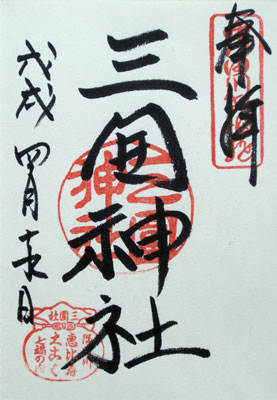
|
| Stamps and calligraphy in my goshuinchō temple stamp book |
The kanji on the column in the picture on the left, on the torii gate in the picture on the right, and in the middle column in the calligraphy of the page in my goshuinchō all read 三圍(神)社, i.e., Mimeguri shrine. The kanji in the calligraphy in the left column of the page in my goshuinchō are 戊戌五月十九日. This translates into the 35th of the sexagenery cycle, the 4th month, the 19th day, and thus in 2018 April 19, which is the date of my visit to the shrine.
Not many Japanese prints seem to have been dedicated to Ushinogozen shrine. Here are two of the four that I found so far:
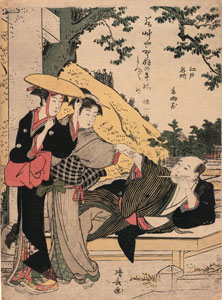
|
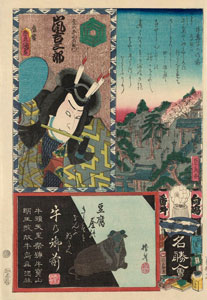
|
| Ushi-no-gozen from the series “Famous Places of Edo” designed by Torii Kiyonaga in 1783 |
Ushi no gozen from the series “Flowers of Edo and Views of Famous Places” designed by Utagawa Kunisada in 1863 |
The Kunisada print on the right displays an image of a cow in its bottom left frame. This refers to the fact that a statue of a cow was donated to the shrine in 1824. This statue has the reputation of healing any kinds of sicknesses: touch the part of the cow’s body where your own body is plagued by any ailment, and remedy will be on its way.
Nowadays the shrine is called Ushijima-jinja shrine and seems to have been moved to the south of Mimeguri shrine. Here are two photos I made of Ushijima-jinja shrine in 2017 as well as the stamps and calligraphy I obtained from a priest at the Ushijima-jinja shrine in my goshuinchō temple stamp book (click to enlarge):
.jpg)
|
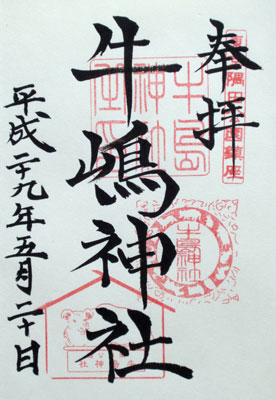
|
.jpg)
|
| Ushinogozen shrine today | Ushijima-jinja goshuinchō stamps and calligraphy | The statue of a cow donated to the shrine in 1824 |
The kanji in the middle column of my goshuinchō page are 牛嶋神社: Ushijima-jinja shrine. The kanji in the calligraphy in the left column of the page are 平成二十九年五月二十日. This translates into Heisei 29, the 5th month, the 20th day, and thus in 2017, May 20 which is the date of my visit to the shrine.